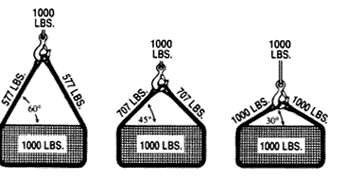Sling Angles
Which Angle Applies? | Angularity Factor (AF) | Sling-to-Load Angle
All Sling angles are measured from the horizontal. As the angle decreases the stress imposed on the leg of a sling increases. A simple demonstration makes this very clear. Imagine one carries a weight with one’s arm hanging down, and then try lifting the same weight sideways up and away from your body. When computing sling capacities always take this most important factor into account. As can be seen from the table sling stresses increase tremendously with angles smaller than 45°. Only where headroom is a limiting factor should sling angles smaller than 30° be applied and careful computation made to ensure that a sling of proper size is used to provide safe working conditions.
 |
 |
 |
 |
Which Angle Applies?
One of the most frequently asked questions. ALWAYS apply the HORIZONTAL sling angle. If you use slings of unequal length apply the SMALLEST sling angle.

Angularity Factor (AF)
Although the known trigonometrical functions apply to all stress calculations, many trade publications and standards give specific sling strength calculation examples which one can follow.
For a ‘day-to-day’ practical calculation we found the following method theeasiest way to determine the sling size required.
| Horizontal Angle | Angularity Facotr (AF) |
|---|---|
| 90 | 1.000 |
| 85 | 1.003 |
| 80 | 1.015 |
| 75 | 1.035 |
| 70 | 1.064 |
| 65 | 1.103 |
| 60 | 1.154 |
| 55 | 1.220 |
| 50 | 1.305 |
| 45 | 1.414 |
| 40 | 1.555 |
| 35 | 1.743 |
| 30 | 2.000 |
| (25) | (2.366) |
| (20) | (2.924) |
| (15) | (3.863) |
| (10) | (5.759) |
|
NOTE: Remember to apply additional reduction factors as required; e.g. Choker Hitch & D/d reduction factors. (..) Angles below 30° should be avoided. |
|
Example:
A 5 ton load has to be lifted with a two 2-leg bridle sling. The horizontal
sling angle is 50°, the slings legs have equal length, and the center
of gravity is in the center of the load.
Solution to find required capacity (or WLL) for EACH sling leg:

3.26 tons is the VERTICAL Rated Capacity required for each sling leg. Look up the tables in this cataloguge and select the sling leg size required.
Sling-to-Load Angle
Slings should be long enough so that the Rated Capacity (WLL) is adequate when the Sling-to-Load Angle is taken into consideration. To avoid edge-loading (unequal loading over the width of the sling) select the longest possible sling or use lifting beams and spreader bars.

Slings should not be loaded in excess of their rated capacity. Shock loading, side loading and inadequate consideration for angular stress adversely affect sling strength.



